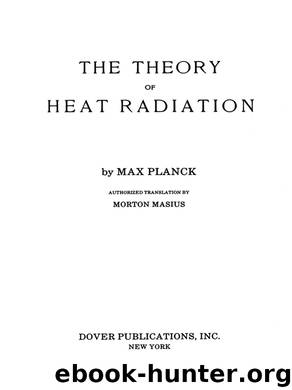The Theory of Heat Radiation by Max Planck

Author:Max Planck [Planck, Max]
Language: eng
Format: epub
ISBN: 9780486173283
Publisher: INscribe Digital
Published: 2012-10-14T16:00:00+00:00
(145)
The principal intensities K0 and K0′ of the ray follow from this expression as the maximum and the minimum value of Kψ according to the equation
Hence it follows that the principal intensities are
(146)
or, by taking (145) into account,
(147)
Then the entropy radiation required becomes:
(148)
106. When two ray components K and K′, polarized at right angles to each other, are noncoherent, K and K′ are also the principal intensities, and the entropy radiation is given by (141). The converse proposition, however, does not hold in general, that is to say, the two components of a ray polarized at right angles to each other, which correspond to the principal intensities K and K′, are not necessarily noncoherent, and hence the entropy radiation is not always given by (141).
This is true, e.g., in the case of elliptically polarized light. There the radiations K and K′ are completely coherent and their entropy is equal to L(K+K′). This is caused by the fact that it is possible to give the two ray components an arbitrary displacement of phase in a reversible manner, say by total reflection. Thereby it is possible to change elliptically polarized light to plane polarized light and vice versa.
The entropy of completely or partially coherent rays has been investigated most thoroughly by M. Laue.32 For the significance of optical coherence for thermodynamic probability see the next part, Sec. 119.
Download
This site does not store any files on its server. We only index and link to content provided by other sites. Please contact the content providers to delete copyright contents if any and email us, we'll remove relevant links or contents immediately.
| Fluid Dynamics | Thermodynamics |
The Complete Stick Figure Physics Tutorials by Allen Sarah(7338)
Secrets of Antigravity Propulsion: Tesla, UFOs, and Classified Aerospace Technology by Ph.D. Paul A. Laviolette(5333)
Thing Explainer by Randall Munroe(3910)
The River of Consciousness by Oliver Sacks(3572)
The Order of Time by Carlo Rovelli(3162)
How To by Randall Munroe(3074)
A Brief History of Time by Stephen Hawking(2992)
I Live in the Future & Here's How It Works by Nick Bilton(2960)
What If?: Serious Scientific Answers to Absurd Hypothetical Questions by Randall Munroe(2669)
The Great Unknown by Marcus du Sautoy(2662)
Midnight in Chernobyl by Adam Higginbotham(2516)
Blockchain: Ultimate Step By Step Guide To Understanding Blockchain Technology, Bitcoin Creation, and the future of Money (Novice to Expert) by Keizer Söze(2467)
Networks: An Introduction by Newman Mark(2382)
The Meaning of it All by Richard Feynman(2319)
Easy Electronics by Charles Platt(2308)
The Tao of Physics by Fritjof Capra(2247)
Midnight in Chernobyl: The Untold Story of the World's Greatest Nuclear Disaster by Adam Higginbotham(2196)
When by Daniel H Pink(2098)
Introducing Relativity by Bruce Bassett(2097)
